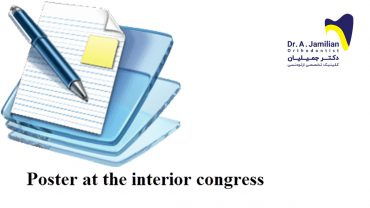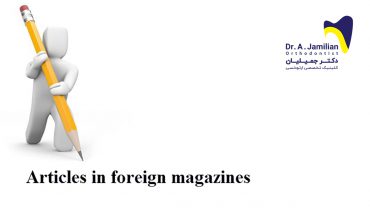Anterior & posterior cross bite
This case report demonstrates an adult patient presenting with a mild class III malocclusion on a moderate skeletal class III base.
Summary:
Mild mandibular asymmetry could be detected. Upper crowding and open bite was obvious in the patient. Anterior and posterior crossbite could also be seen. She had lower lip protrusion due to Class III malocclusion. She had mild asymmetrical face.
Examination of head and face:
In the frontal plane the face is mildly asymmetrical specially when smiling. In the sagittal plane the face is flat with protruded lower lip and normal upper lip. Mild strain could be detected while closing the lips. The patient had nasal septal correction surgery when she was 18 years old, but still nasal deviation could be clearly noticed in her face which pronounced her asymmetrical look.
Functional examination:
Mild mandibular deviation on closing the mouth could be seen. Centric occlusion and centric relation were coincident and there were no temporomandibular joint signs or symptoms. Despite the deviation she had no clicking or pain on opening and closing. No muscle pain was detected on palpation.
Intra-oral examination:
The patient had Class III malocclusion in the permanent dentition. Open bite was obvious. Anterior and posterior crossbite and crowding in the upper jaw could also be seen. 46 and 47 had restoration and root canal therapy. The high caries rate was indicative of poor oral hygiene. Third molars in the lower jaw had erupted but they had not yet been erupted in the upper jaw.
Treatment plan:
The chief concerns were as following:
Class III malocclusion specially protrusion of lower lip
Open bite
Upper crowding
Anterior and posterior crossbite
Flared lower incisors
Avoiding invasive surgical procedures
Cephalometric assessment implied that the patient is a case for surgical orthodontic treatment; however, the patient strongly rejected surgery due to her previous unsuccessful surgical experience. Therefore, orthodontic camouflage of Class III malocclusion was chosen. Posterior extraction was considered in order to reduce the open bite, relieve the upper crowding, avoid retracting of upper incisors, and retract the lower incisors to achieve favourable overjet and overbite. Lower lip protrusion would also be corrected by the retraction of lower incisors. Skeletal Class III relationship and the anterior cross bite could be favoured by an upper incisor proclination and lower incisor retraction. Posterior extraction is usually needed for correction of anterior open bite; In this patient 15, 25, 35, and 46 were extracted. Tooth 46 was chosen for extraction due to its bulky restoration and root canal therapy.
Treatment results:
The patient required orthognathic surgery; however, she was treated by camouflage. The treatment resulted in an improvement in facial aesthetics. The patient’s soft and hard tissues are acceptable. Full Class I molar and canine relationship on the left side were established. Due to the extraction of the right mandibular first molar and right maxillary second premolar Class II molar relationship was established on the right side. Positive overjet and overbite were achieved as a result of proclination of the upper incisors and retroclination of the lower incisors. The lower right second molar was moved mesially about 11 mm. Patient’s asymmetrical smile has been corrected to a great degree due to correction of her posterior cross bite. The patient’s profile has been improved and lower lip protrusion has been corrected. The temporomandibular joints showed no clicking on opening and closing and maximum opening of the jaws was normal. No mandibular deviation could be detected upon opening and closing of the mouth. Slight asymmetrical face which could be seen after treatment was due to the asymmetrical nose of the patient. Skeletal Class III compensation was achieved during 24 months of treatment. There were no maxillary or mandibular growth during this time and the mandibular backward rotation was due to arch levelling and aligning. Upper right third molar had no contact in the lower jaw; thus, the patient was referred to a general dentist for its extraction and filling of some other ones. Upper and lower Hawley retainers were decided for retention in order to preserve incisors’ inclination. The retainers were worn on a full time basis for the first 6 months and then on a part time basis for a further 6 months after which their use was discontinued.
Retention:
14 months after removal of Hawley retainers the patient was examined at the office. She was normally examined every 6 months; however, the satisfactory results achieved and her preoccupation caused her to extent the second visit to 8 months. Her occlusal relationship was still satisfactory and the facial aspect was maintained. More restorations could be seen on some teeth. There was no sign of Class III malocclusion. No open bite tendency could be detected in the patient and no signs and symptoms of temporomandibular dysfunction were noted.
Cephalometric Data:
| Pretreatment | Posttreatment | Mean SD | ||
| Sagittal Skeletal Relations | ||||
| Maxillary Position S-N-A | 78° | 78° | 82º ± 3.5º | |
| Mandibular Position S-N-Pg | 78° | 78° | 80º ± 3.5º | |
| Sagittal Jaw Relation A-N-Pg | 0° | 0° | 2º ± 2.5º | |
| Vertical Skeletal Relations | ||||
| Maxillary Inclination S-N / ANS-PNS | 10° | 10° | 8º ± 3.0º | |
| Mandibular Inclination S-N / Go-Gn | 37° | 37° | 33º ± 2.5º | |
| Vertical Jaw Relation ANS-PNS / Go-Gn | 26° | 26° | 25º ± 6.0º | |
| Dento-Basal Relations | ||||
| Maxillary Incisor Inclination 1 – ANS-PNS | 109° | 113° | 110º ± 6.0º | |
| Mandibular Incisor Inclination 1 – Go-Gn | 91° | 87° | 94º ± 7.0º | |
| Mandibular Incisor Compensation 1 – A-Pg (mm) | 6 mm | 3 mm | 2 ± 2.0 | |
| Dental Relations | ||||
| Overjet (mm) | -1 mm | 2 mm | 3.5 ± 2.5 | |
| Overbite (mm) | -2 mm | 2 mm | 2 ± 2.5 | |
| Interincisal Angle | 131° | 137° | 132º ± 6.0º |
The following images show the pre and post treatment lateral cephalogram and OPG of the patient:


